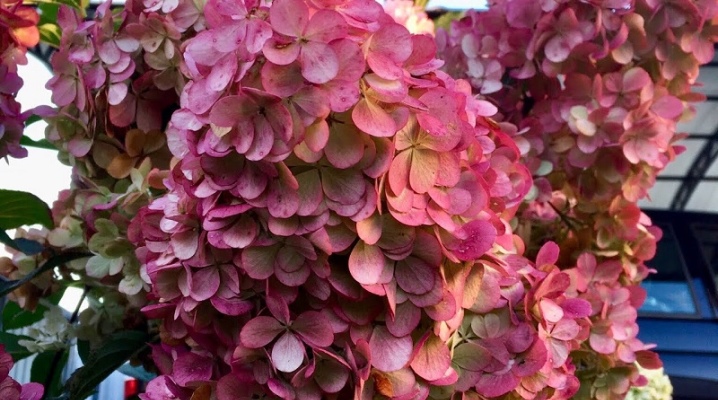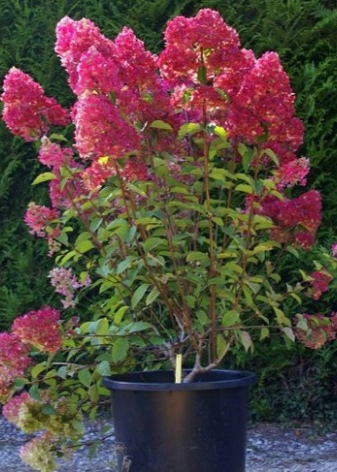Hydrangea "Samara Lydia": description, recommendations for cultivation and reproduction

Hydrangea is one of the most popular plants in summer cottages and city flower beds. Various varieties are appreciated not only in Russia, but also in China, Japan and even in America. Flower growers are attracted not only by large colorful inflorescences, but also by their unpretentious care. A special place in the flowerbed is occupied by paniculate species, for example, the new variety "Samarskaya Lydia".


Description
The variety presented for the first time was demonstrated at the international flower exhibition in September 2018, and in the spring of 2019 the culture went on sale. The Samarskaya Lydia variety was bred in a French nursery. The plant belongs to the group of low-growing compact hydrangeas up to 1.3 m high and up to 1.1 m wide. It can be used for container planting.
It is characterized by long flowering in summer and autumn. It has strong red shoots with rough foliage of a dark green color. Each shoot includes a 15 cm long cone-shaped inflorescence that rapidly changes color as it blooms. The inflorescence is a group of large flowers closely adhered to each other, which bloom in white and gradually turn pink and red.
The variety belongs to the fourth climatic zone, is frost-resistant, tolerates winters well, quickly adapts to the harsh climate of the middle zone.



Landing
Paniculate varieties love sunny areas, but the problem is that they bloom quite quickly in abundant sunlight. To extend the flowering period, it is recommended to plant the plant in an area that is shaded at noon. The conditions under which the sun will illuminate the culture until 14 o'clock are also suitable.
Planting in open ground is done in May or September. You need to choose a warm day for planting, so that the seedlings are planted in warm soil. A favorable condition for the presented variety is an acidic soil with high humidity and good air permeability. A suitable composition can be achieved by applying fertilizers with citric acid, peat, or minerals with ferrous sulfate or ammonium sulfate.
Both the development of the plant and its color during flowering depend on the level of acidity.



The planting process is as follows.
- Dig a hole with a diameter of 2 times the roots of the bush.
- Pour crushed stone into the hole. It will serve as a drain.
- The next layer is black soil with the addition of sand and peat in equal proportions.
- Carefully remove the seedlings from the container along with the earthy clod and plant the seedling in the prepared hole.
- Fill the free space with soil and compact the earth slightly.
- Water the seedling liberally with rainwater.
- For a group planting, an adjacent specimen should be planted at a distance of at least 2 meters.


Care
A newly planted flower needs love and care. At first, it is better to cover the plant with a film that reflects the sun's rays, it will save the seedlings from burnout. To protect the culture from wind and draft, gardeners are advised to install a small stake near the bush and lightly tie the seedling to it.
In order for the plant to develop well, it needs to be fed periodically. Seeing the tarnishing of the color of the green mass and yellowness, it can be assumed that the culture is deficient in nutrients. Spring feeding must be carried out without fail, during this period the flower needs nitrogen-containing substances. Manure or compost will also work. In total, the plant should be fertilized 2-3 times in the spring.Exceptions are specimens that were planted with the use of minerals - such specimens can not be fed for the first 1-2 years.


Water the hydrangea once a week. Watering is done at the root so that water does not get on fragile branches. The recommended portion is a bucket for a young plant, two buckets for an adult. The water should not be harmful to the culture of lime. Rainwater is best. To create an aesthetic shape, the shrub is pruned. For this, in the spring, frozen, dry, damaged branches and deformed young shoots are removed. The first haircut can be done within a couple of years after planting.
This is a winter-hardy variety, but still additional insulation for the winter will not be superfluous. Before frosts, the soil is well moistened, the lower leaves are cut off, an air cushion of dry foliage, moss and grass is prepared for the roots, and the bush is covered with a film on top.
Hydrangeas have a high immunity to diseases and pests, and therefore they do not need protective treatment against these ailments.



Reproduction methods
It is possible to breed paniculate hydrangea using the following methods.
By cuttings
To do this, cuttings are cut during the period of bud swelling. Each instance includes two internodes, the lower cut is made at an angle of 45 degrees, and the upper one is straight. A mixture of sand and peat is suitable for planting, cuttings are planted into the finished substrate, deepening by 3-4 cm, the container is removed to a warm, lighted place. Some gardeners create a greenhouse effect by covering the container with plastic.
Further care consists of watering and airing. When the cuttings are rooted, they can be planted in the area. Usually, transplantation to a permanent place is carried out 1-2 months after rooting. In winter, these plants require additional shelter.



Air layering
The simplest and most common breeding method. Choose the sturdiest and strongest shoot, gently bend it to the ground and lightly dig in. To secure the layering, you can use staples, stone or brick. The planting site needs regular watering, but top dressing is not needed. After a year, a new copy can be separated from the parent and planted in a permanent place.


Seeds
The most difficult and time-consuming method, which, moreover, gives little guarantee that the seedling will be promising. In addition, new shoots can make a significant difference compared to the parent bush. Sowing is carried out in the fall. A mixture of peat, leafy earth and sand is suitable as a substrate. Planting is done in a shallow pot. It is not necessary to deeply deepen the planting material, since the seedlings are small in size and may not germinate - you can even just sprinkle the seeds over a moistened surface and lightly tamp them. Next, the seedlings should be covered with a film and removed daily to ventilate the plants and water them. Favorable temperature above the surface is +20 degrees. The first shoots can be observed after 1-1.5 months - on this day, the film is removed and re-installed only in the evening.
Seedlings are dived twice and replanted. For the winter, it is better to put them in a room or greenhouse, where the temperature is 20-25 degrees. At this time, the plants need watering, sometimes they need to be fertilized with nitrogen. Only 1.5-2.5 years after sowing, the seedlings will be ready for transplanting into open ground.


Before that, it is customary to temper young specimens: for this, during the day they are taken out into the open air, gradually leaving them outside and overnight.
In the next video you will see a presentation of the hydrangea "Samara Lydia".



































































The comment was sent successfully.